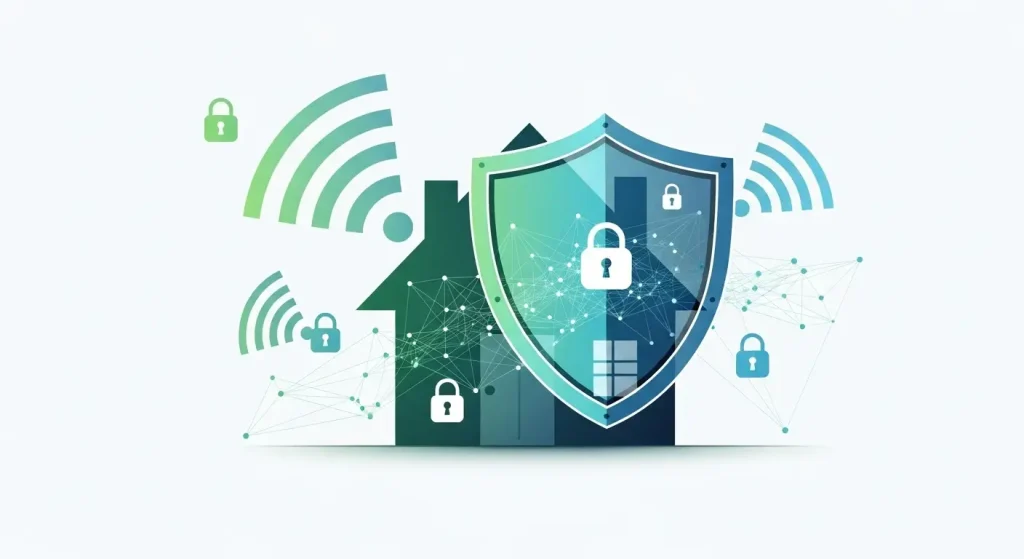In today’s digital age, home cybersecurity has become more critical than ever. With cyber attacks increasing by 38% in 2024 and millions of households working remotely, protecting your home network and personal data isn’t just recommended—it’s essential. Whether you’re a tech novice or seasoned user, implementing these essential cybersecurity tips can safeguard your digital life from malicious threats.
Electric Cars in 2026: A Buyer’s Guide for US & Europe
Why Home Cybersecurity Matters More Than Ever
Your home networks might have a range of wireless devices on them — from computers and phones to IP cameras, voice assistants, smart TVs, and connected appliances, creating multiple entry points for cybercriminals. A single compromised device can provide hackers access to your entire network, putting sensitive information like banking details, personal photos, and work documents at risk.
The consequences of poor home network security extend beyond identity theft. Cybercriminals can:
- Access your webcams and microphones
- Monitor your internet activity
- Steal cryptocurrency and digital assets
- Use your devices for illegal activities
- Hold your files hostage through ransomware
1. Secure Your Wi-Fi Network with Strong Encryption
Your Wi-Fi network serves as the gateway to your digital world, making Wi-Fi security your first line of defense. CISA recommends using the Wi-Fi Protected Access 3 (WPA3) Personal Advanced Encryption Standard (AES) and Temporary Key Integrity Protocol (TKIP), which is currently the most secure router configuration available for home use.
Steps to Secure Your Wi-Fi:
- Change Default Router Credentials: Replace manufacturer default usernames and passwords immediately
- Enable WPA3 Encryption: If unavailable, use WPA2 as a minimum standard
- Create a Strong Network Name: Avoid revealing your router brand or personal information
- Disable WPS: Wi-Fi Protected Setup creates unnecessary security vulnerabilities
- Hide Your Network: Disable SSID broadcasting to make your network less visible
For a secure home network, it is a good idea to change your password regularly – every six months or so, ensuring ongoing protection against potential breaches.
Top Digital Nomad Destinations in Europe: Your Complete 2025 Guide
2. Implement Robust Password Protection Strategies
Password protection remains one of the most critical aspects of cybersecurity, yet 81% of data breaches involve weak or compromised passwords. Creating and managing strong passwords across all your devices and accounts significantly reduces your vulnerability to cyber attacks.
Password Best Practices:
- Length Matters: Use passwords with at least 12-16 characters
- Complexity is Key: Include uppercase letters, lowercase letters, numbers, and special characters
- Unique for Each Account: Never reuse passwords across multiple platforms
- Use Password Managers: Tools like Bitwarden, LastPass, or 1Password generate and store complex passwords
- Enable Two-Factor Authentication: Add an extra security layer wherever possible
Consider using passphrases instead of passwords. For example, “Coffee&Sunrise@7AM!” is both memorable and secure, combining length with complexity.
3. Keep Your Antivirus Software Updated and Active
Antivirus software serves as your digital immune system, detecting and neutralizing threats before they can cause damage. If you run Windows you have Windows Security already installed on your device, but additional protection may be necessary depending on your usage patterns.
Choosing the Right Antivirus Protection:
| Feature | Free Antivirus | Premium Antivirus |
|---|---|---|
| Real-time Scanning | ✓ | ✓ |
| Firewall Protection | Limited | ✓ |
| Email Protection | Basic | Advanced |
| VPN Access | No | ✓ |
| Identity Monitoring | No | ✓ |
| Tech Support | Limited | 24/7 |
Antivirus Best Practices:
- Enable Automatic Updates: Ensure your antivirus database stays current
- Schedule Regular Scans: Run full system scans weekly
- Monitor Real-time Protection: Keep active scanning enabled
- Avoid Multiple Antivirus Programs: They can conflict and reduce effectiveness
- Update Operating Systems: Keep Windows, macOS, or Linux current with security patches
Essential Tips for Negotiating a Salary Increase: Expert Guide
4. Secure Your Smart Home Devices
The Internet of Things (IoT) has revolutionized home convenience but introduced new security challenges. Change default passwords and update firmware regularly to fix known bugs or vulnerabilities. Disable remote access unless absolutely necessary to minimize external exposure.
IoT Security Checklist:
- Create a Guest Network: Isolate smart devices from main computers and phones
- Regular Firmware Updates: Enable automatic updates when available
- Review Device Permissions: Limit access to cameras, microphones, and location data
- Monitor Network Activity: Use network monitoring tools to detect unusual behavior
- Research Before Purchasing: Choose devices from reputable manufacturers with strong security records
5. Practice Safe Online Behavior
Cyber threats often exploit human psychology rather than technical vulnerabilities. Developing awareness of common attack methods helps you avoid falling victim to social engineering and phishing attempts.
Red Flags to Watch For:
- Urgent Email Requests: Legitimate companies rarely demand immediate action
- Suspicious Links: Hover over links to verify destinations before clicking
- Unexpected Attachments: Don’t open files from unknown senders
- Public Wi-Fi Risks: Avoid accessing sensitive accounts on open networks
- Software from Unknown Sources: Download applications only from official stores
Safe Browsing Habits:
- Use reputable browsers with security extensions
- Keep browsers updated with latest security patches
- Enable automatic security warnings
- Clear cookies and cache regularly
- Use VPN services for enhanced privacy
Beginner’s Guide to Freelancing Platforms (Upwork, Fiverr, etc.)
6. Regular Data Backup and Recovery Planning
Data backup serves as your safety net when cyber attacks succeed despite preventive measures. The 3-2-1 backup rule provides comprehensive protection: maintain 3 copies of important data, store them on 2 different media types, and keep 1 copy offsite.
Backup Strategy Options:
Cloud Backup Services:
- Automatic synchronization
- Access from multiple devices
- Professional-grade security
- Subscription costs
- Internet dependency
Local Backup Solutions:
- Complete control over data
- One-time hardware costs
- Faster restoration times
- Risk of physical damage
- Manual management required
7. Keep Software and Systems Updated
To minimize vulnerabilities and improve security, the routing devices on your home network should be updated to the latest patches, preferably through automatic updates. Software updates often include critical security patches that address newly discovered vulnerabilities.
Update Priority List:
- Operating Systems: Windows, macOS, Linux security updates
- Web Browsers: Chrome, Firefox, Safari, Edge patches
- Router Firmware: Often overlooked but critically important
- Mobile Apps: Both security and social media applications
- Smart Device Firmware: TVs, cameras, smart speakers
Enable automatic updates whenever possible to ensure timely protection against emerging threats.
Clean Beauty Products with Viral Appeal
Monitor Your Digital Footprint
Understanding what information you share online helps minimize your exposure to home network security threats. Regular monitoring of your digital presence can reveal potential vulnerabilities before criminals exploit them.
Digital Footprint Audit:
- Review privacy settings on social media platforms
- Monitor credit reports for suspicious activity
- Use identity monitoring services
- Limit personal information sharing
- Regularly search for your name online
Frequently Asked Questions
What are the most essential cybersecurity measures for home users?
The most essential home cybersecurity measures include: using strong, unique passwords with two-factor authentication; keeping all software and firmware updated; securing your Wi-Fi network with WPA3 encryption; installing reputable antivirus software; and creating regular data backups. These five steps provide fundamental protection against the majority of cyber threats targeting home users.
How often should I update my home network security settings?
You should review your home network security settings quarterly and update passwords every 3-6 months. Router firmware should be updated as soon as patches become available, typically every 2-3 months. Additionally, audit connected devices monthly to ensure only authorized devices access your network, and review access logs if your router provides this feature.
Can free antivirus software provide adequate protection for home use?
Free antivirus software can provide basic protection for home users with simple computing needs. However, premium solutions offer additional features like advanced firewall protection, email security, VPN access, and identity monitoring. For households with multiple devices, smart home equipment, or users who frequently download files and visit various websites, premium antivirus protection provides more comprehensive security coverage.
Meal Planning for Weight Loss Ultimate Guide
Take Action to Protect Your Digital Life Today
Implementing these essential cybersecurity tips doesn’t require technical expertise—just commitment to your digital safety. Start with the most critical steps: securing your Wi-Fi network, updating your passwords, and installing reliable antivirus software.
Remember, home cybersecurity is an ongoing process, not a one-time setup. Stay informed about emerging threats, regularly update your security measures, and maintain good digital hygiene habits.
Ready to upgrade your cybersecurity protection? Explore professional-grade security solutions and take advantage of expert recommendations.
Complete antivirus suite with VPN and password manager :
High-performance router with advanced security features:
Multi-platform cybersecurity solution :
Physical two-factor authentication device :
for the latest cybersecurity tools and services tailored for home users.











